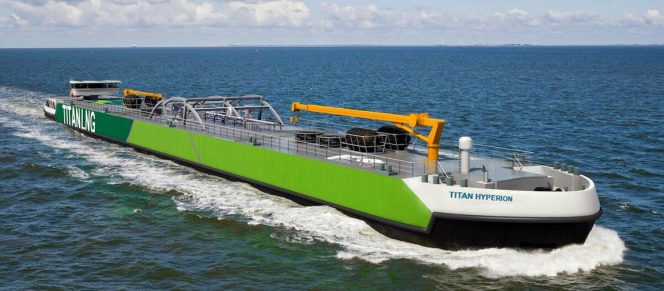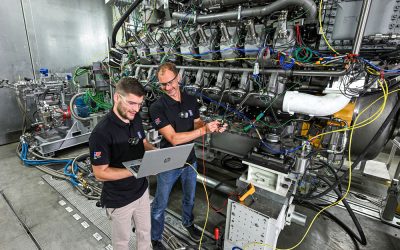Titan LNG has developed an innovative concept for the fuel storage tanks used in its liquid gas bunker barge design series ‘Hyperion’. The 8,000m3 inland waterway version will specifically target the market for LNG and bio-LNG for larger ocean-going vessels in the Amsterdam-Rotterdam-Antwerp region and will boost supply and bunkering in the region.
The rationale for the new tank design comes from Titan LNG’s experience with the two LNG bunker barges it currently operates, the FlexFueler 001 and 002. The FlexFueler concept was developed in-house by Titan LNG, and this helped the company gain extensive experience with the European Inland Waterway (IWW) regulations, specifically its impact on LNG storage and handling systems.
Since the FlexFueler 001 entered service in 2019, continued market growth and the higher tank capacity of the global fleet of LNG-fuelled vessels has led to demand for more and larger IWW dedicated bunker barges.
The ability to scale bunkering capacity up efficiently to meet this type of growing capacity is made difficult by a particular rule in the European code for carriage of dangerous goods. Namely, a tank capacity limit of 1,000m3 per tank onboard gas carriers. Which – when conventionally interpreted – leads to a multiple of 1,000m3 cylindrical tanks. Though certainly valid from a safety perspective, the rule is a challenge when scaling up liquefied gas carriers as it tends to lead to designs with many small – and relatively expensive – tanks.
The solution: tank partitions
Titan LNG has devised a way to meet this safety criterion by introducing the principle of multiple 1,000m3 internal tank partitions into a single tank structure. The main benefit is that more fuel can be put into a single tank structure. As a result, the tanks take up less space, thus reducing the total footprint of the vessel while maintaining the cargo capacity. The internal partitions maintain their individual structural integrity in case of damage to a single partition, which can cause challenging combinations of vapour and hydrostatic pressure differences. This solution has been patented as well as technically validated by Titan LNG for one of the more challenging types of pressure vessel; a bilobe tank.
In relation to boil-off gas, sloshing and slamming resulting from ocean voyages, the tank performs in the same way as a typical Type C tank. As Type C is designed for high vapour pressures, sloshing and slamming rarely govern structural load cases and each partition may be seen as a structurally individual tank. The considerations for tank support, inerting the space around the tank, and material fatigue are also no different to other Type C tanks. The only difference is that tank domes should be grouped together around the fixed support (allowing for no lateral movement due to temperature variations). This results in a central fixed support and two outer sliding supports. The new design does not affect bunkering procedures, equipment, or safety either. It uses the same number of pumps and the same transfer equipment as conventional IWW-compliant designs.
The larger tank size also creates the possibility of using lighter and cheaper foam insulation instead of the vacuum-insulated pressure tanks that are more common in tanks that are over 1,000m3 in capacity. This insulation concept has already been technically validated.
More efficient use of space offered by the new tank design meant that the vessel’s length and breadth could be reduced by 10-20%, compared to a design with multiple individual cylindrical tanks. Fuel consumption, steel weight, outfitting costs and overall environmental impact of constructing and operating the vessel were reduced by similar percentages.
Growing potential
When combined with Titan LNG’s broader design requirements for LNG bunker vessels it was found that the vessel lay-out of Hyperion could work as both an inland and seagoing vessel. As a result, the Hyperion design series currently features both seagoing and inland versions, making it ready for the market developments next decade and beyond.
Next to join the two FlexFuelers and the Hyperion will be the Titan Krios bunker barge(s), increasing the accessibility of LNG as a marine fuel in the Port of Zeebrugge and in the English Channel ports from 2024. In line with Titan LNG’s design philosophy, Krios is a compact seagoing LNG bunker vessel having 4,500m3 in capacity, thereby offering effortless client compatibility by virtue of its low air draught, high manoeuvrability, and small footprint.
Krios, which will fulfil part of the base demand in Zeebrugge that Titan LNG is already supplying, will operate with multiple tanks to segregate streams of LNG and bio-LNG – the sustainable carbon neutral fuel produced from biological waste streams. As it can be stored and supplied using existing infrastructure, blended with LNG, and dropped into existing engine technology, bio-LNG presents a financially sound long-term investment for many operators and owners looking to decarbonise operations, and comply with emission reductions regulations.
LNG and bio-LNG create a pathway to decarbonisation that leads to the introduction of hydrogen-based LNG which can use the same storage and handling infrastructure and engine technology. Liquid biogas – from organic waste – and liquid synthetic methane – from green hydrogen and captured CO2 – are scalable solutions for the maritime sector, and the expanding LNG infrastructure in EU ports such as the Port of Antwerp is fully future-proofed and able to supply carbon-neutral LNG.




